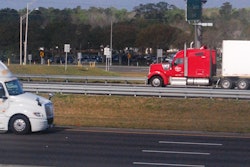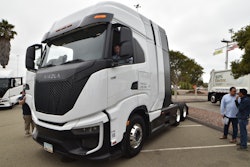There’s green and then there’s greener. And that’s just the first milestone to greenest. Getting as far down that sunshiny road as possible will require gauging the full carbon footprint of the zero-emission vehicle (ZEV) trucks steadily rolling into trucking. But determining that is about much more than how electric-drive technologies erase all harmful exhaust and tailpipe emissions.
Right now, the greenest choice for medium- and heavy-duty trucks is a battery-electric vehicle (BEV). The other alternative, which is largely still under development, is the hydrogen fuel-cell electric vehicles (FCEV). So, two different ways to go electric – and both cases require a full look at their total carbon footprint.
A recent American Truck Research Association (ATRI) research report neatly spells out the big picture: “From a lifecycle perspective… ZETs [zero-emission trucks] are still responsible for generating greenhouse gases, such as carbon dioxide (CO2), which is tied to climate change. While CO2 emissions are not directly released by a ZET during operations, such emissions are released during the production of ZET fuels (electricity and hydrogen) and the production and disposal of ZET vehicles and their electricity storage equipment (lithium-ion batteries).”
For the moment, the focus on carbon footprint falls fully on BEVs. According to researcher Matteo Muratori, group manager at the National Renewable Energy Laboratory, NREL projections hold that “BEVs could become cost-competitive for smaller trucks this decade and for most heavy trucks by 2035. Meanwhile, FCEVs could become cost-competitive for long-haul heavy trucks in the 2030s."
Tipping the scales
Generating no emissions while the ignition is switched on is the biggest positive carbon reduction of electric trucks. However, offsetting that plus is the carbon produced during the BEV’s cradle-to-grave lifecycle, starting with its manufacture and the raw material mining necessary, and then onto the electricity that drives its battery-charging.
On the other hand, also having a positive carbon impact would be any recycling or reuse of the truck’s lithium ion batteries (LIBs) as well as any “circular economy” recycling of the BEV’s steel, aluminum, copper, other metals, electronics, and reusable plastic and composite materials, including tires.
So, the mission charged to everyone from mineral miners to truck builders to battery manufacturers and charging providers-- as well as local electric utilities-- is to search out and implement ways all along the supply chain to cut carbon output, from designing trucks to recycling them.
Shrinking the carbon footprint of EVs means no stone can be left unturned. A Daimler Truck North America (DTNA) spokesperson told CCJ that the OEM views “sustainability holistically as an integral part of our core business and our corporate behavior. We want to contribute to the fight against climate change [and] the most important levers for this are our products, our production, and our supply chain.”
One example of offsetting cited by DTNA is the C02-neutral design of the company’s EV plant in Portland, OR. Another is that the truck maker “will leverage the entire battery lifecycle, which includes remanufacturing, repurposing (energy storage), and end-of-life recycling.” In addition, “innovation projects are underway to explore battery second-life usage and storage.
“Battery storage is one of the ways we plan on taking advantage of the battery’s lifecycle,” the spokesperson continued. “Energy storage is an essential component in addressing the infrastructure requirements to support BEV. DTNA is collaborating with experts in the energy storage space to develop and test prototypes to provide solutions for our customers’ unique needs.”
According to Volvo Trucks, the lifecycle expectations for batteries powering heavy trucks varies, depending on such factors as application, temperatures, charge/discharge cycles, etc. Generally, the OEM calculates around 8 to 10 years for the battery in its first mobile application. After that, battery may see more life in a less heavy application or as part of an energy storage system.
At a recent media briefing, Lars Martensson, Director of Environment and Innovation for Volvo Trucks, took a wider view, contending that the carbon offset gained by moving from a linear truck lifecycle that ends in a scrap yard to a model that embraces the circular economy. “If we have resources and we extract them, why throw them away?” Looking at lifecycle this way, he said, “we don’t see a truck as waste at the end of its life. We see it as a resource.”
Battery dilemma
But to start at the beginning of the battery dilemma, peer into the mines that give up the rare minerals needed to produce all those batteries for BEVs. McKinsey & Co. consultants pondered this aspect in a recent brief on how manufacturing lithium-ion batteries itself is highly carbon-intensive. In short, “making batteries can generate as much emissions as producing all the other materials that go into making an EV— or even more,” state the authors.
Fortunately, this major bump in the road is being tackled by vehicle manufacturers and battery suppliers. “Emission levels from EV battery production depend on a variety of factors, including design choices, vehicle type, range, and freight requirements, as well as production and sourcing locations,” the consultants note.
“The energy sources used to produce various battery components are one of the biggest factors explaining the wide variation in the carbon footprint of different OEMs,” they add. “The good news is that steep reductions in the carbon emissions from EV battery production are possible in the next five to ten years.”
Green electricity
The key to cutting carbon production during electric-truck manufacturing is to power assembly operations with “green” electricity, which is generated from sources that produce a smaller carbon footprint than traditional coal-fired powered plants.
For example, GE Renewable Energy is making this switchover for its manufacturing plants by placing “a strong focus on reducing our emissions through energy efficiency and reduction efforts.” However, the electricity consumption for its manufacturing still represents a significant proportion of the business unit’s carbon footprint.
To counteract that, the manufacturer is committed to consuming “100% renewable electricity” at all its sites. To get there, GE Renewable Energy will leverage “absolute reductions of direct emissions and energy use achieved through operational investments, smart power sourcing, and elimination of waste [and] where necessary, we will balance remaining emissions with carbon offsets.”
Charging impact
As with manufacturing trucks, charging their batteries consumes electricity that is generated at power plants. And not to be overlooked are all the recharging cycles required during the service life of just one electric truck. But at least this is an arena in which truck fleet operators can make a substantial positive impact.
When, where, and how are the roads to greening recharging, reveals a University of Michigan study released in 2021. The U-M researchers found that 50% to 80% of the lifetime emissions associated with an electric delivery vehicle’s battery occur during charging.
Hence, charging from a cleaner energy source— such as an electrical grid powered by various renewable energy sources— is “one of the most impactful ways to lower the emissions of an electric vehicle.” Factoring in both charging cycles and battery degradation, the researchers determined that greenhouse gas emissions could be cut by as much as 37% through charging strategies.
“Our evaluation strategy leads to two main recommendations for companies investing in fleets of electric vehicles,” said Maxwell Woody of U-M’s Center for Sustainable Systems, the study’s lead author. “The first is to consider battery degradation when determining when to charge and how much to charge. Some charging strategies can extend battery lifetime, and this will both lower greenhouse gas emissions and protect the company’s investment.”
The U-M team’s second recommendation is to consider where the energy charging the vehicle is generated: “A vehicle charged from solar or wind energy and a vehicle charged from a coal- or natural gas-fired power plant will have very different environmental impacts.”
“Considering the charging source can help companies determine the best places to charge, as local grids vary across the country,” noted Woody. “Companies should prioritize fleet electrification in regions that provide the greatest carbon-reduction benefits.”
Takeaways from the researchers’ analysis of charging strategies and their lifetime carbon impact include:
· A baseline charging scenario in which a vehicle is fully charged immediately on return to a central depot garnered the highest emissions. But employing alternative charging methods led to emissions reductions of 8% to 37%.
· Charging the battery only enough to complete the day’s route, a practice the researchers called “sufficient charging,” spurred a large increase in battery lifetime; even to the point of doubling it. The upshot is emissions tied to battery production were reduced.
· In most cases, delaying charging until the vehicle was close to departure, combined with sufficient charging, was the optimal strategy for both reduced operating costs and carbon footprint.
That’s the bird’s eye view of the complicated carbon footprint of today’s electric trucks. As to where all this is headed, consider that the Department of Energy holds that by 2030, “nearly half of medium- and heavy-duty trucks will be cheaper to buy, operate, and maintain as zero emissions vehicles than traditional diesel-powered combustion engine vehicles.” And that is just one green milepost of many ahead.














